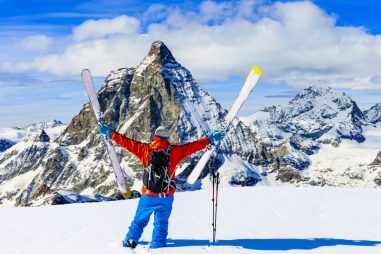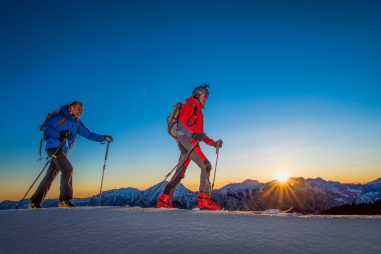Exploring the beauty of the snowy mountains is one of the main appeals of ski touring. But it requires the proper equipment and setup for your enjoyment and safety.
This starts with your skiing equipment. You need the correct skis, boots, bindings, and poles specific for ski touring. Then you have your backpack with other gear and essentials, which you can’t leave behind.
If you’re worried about the right ski touring setup, here’s everything you need to know so you can start in no time.
How Do I Choose Skis for Ski Touring?
When it comes to ski touring, there are some considerations in choosing your ski. There’s no single type of ski that anyone should go for. There are plenty of options when it comes to skis specific for ski touring.
But you should aim for a balance between maneuverability and stability. So you should take the following into account:
- The Season: You’ll experience different snow types during the winter or summer season.
- Your Ski Level: Are you a mellow or aggressive skier? How you ride and your skill level should be appropriate to the skis you’re using.
- Ski Width: The wider the ski, the heavier it is. This is better for variable conditions and deep snow. Meanwhile, narrower skis are lighter and offer better handling during technical descents.
- Ski Length: The general rule for touring skis is to subtract 5 to 15 cm (1.9 to 5.9 inches) from your height. But you’ll also find recommendations from manufacturers and experts. You can also opt to follow those.
Do You Need Special Skis for Ski Touring?
Ski touring requires skis with specific functions. This is similar to what you’ll find in skis used for backcountry or cross-country skiing.
These are different from resort skis where your feet are locked in on the ski through the boots. For ski touring, the heel needs to be detached so that you can walk on your skis when you ascend.
But you’ll also find skis designed specifically for ski touring. They’re lighter than your regular resort skis to make skinning and ascents easier.
When it comes to size, it comes down to your preference. Do you want more float or maneuverability? Wider skis offer more float on deep snow while shorter skis are more maneuverable.
Can You Use Any Skis for Ski Touring?
Generally, you can use any ski designed for backcountry skiing for ski touring. These skis are designed for offtrack skiing and will be good enough if you’re just ski touring for fun.
But if you’re aggressive and more serious about ski touring, it’s best to use skis specific for this type of skiing.
What Size Skis for Ski Touring?
The ski size you need depends on what you want. If you’re uphill-focused, your skis should be shorter and lighter to make them easier to maneuver. If you’re downhill-oriented, then wider skis are the best choice for deep powder.
But if you prefer the in-between game, skis with moderate weight and width are also available.
How Long Should Ski Touring Skis Be?
Generally, ski touring skis should be 5 to 15 cm (1.9 to 5.9 inches) shorter than your height. This typically applies to beginners or intermediate skiers who want to ski for fun.
But advanced skiers use skis as tall as they are. This isn’t an issue because of their skill level.
Do You Need Special Bindings for Ski Touring?
Ski touring requires special bindings. In alpine skiing, your boots are completely locked to the skis. Backcountry or cross-country ski bindings only connect the boots to the ski at the toe part only.
Ski touring bindings allow you to do both. During the climb, your heels are detached. Then you can lock your heels to your ski when you descend.
What Are Ski Touring Bindings?
Ski touring bindings are what connect your boots to the ski. It’s an essential part of your gear. It’s also what makes it possible for you to walk on your skis on flat terrain or when going uphill.
For ski touring, there are two kinds to choose from: pin and frame bindings. Each one has characteristics that can affect your touring experience.
How Do Ski Touring Bindings Work?
Ski bindings are responsible for locking your boots on the skis. With the toes attached to the ski, your heels are free which allows you to walk or climb while wearing your skis.
Aside from connecting your boots to the ski, they also:
- Prevent unwanted release which can cause accidents,
- Allow you to release your skis when you fall.
With pin bindings, your boots are secured by two metal pins at the toe area. This setup reduces a significant amount of weight. It’s also more comfortable during climbs. Because of this, more experienced skiers who want lighter gear prefer pin bindings.
As for frame bindings, it secures the boot through a metal frame found between the toe and the heel. This offers more safety features compared to pin bindings. This makes it ideal for beginners.
Do You Need Special Boots for Ski Touring?
Ski touring involves a lot of skinning or skiing on flat terrain or uphill. To do so efficiently, you’ll need boots that are flexible and comfortable. Using alpine-skiing boots won’t suffice.
Alpine boots are incompatible with ski touring bindings. They’re also more rigid, making skinning impossible.
What Are Ski Touring Boots?
Ski touring boots are designed for skinning and downhill skiing. Made of lighter and softer materials, they’re more flexible and comfortable when skinning.
They also have a hike mode. This gives the feet more space to flex when walking. Then downhill mode provides more support during descents.
How Do I Choose Ski Touring Boots?
In choosing ski touring boots, you need to consider the following:
- Fit: Finding the right fit can be tricky. The best way is to visit a shop and try on the boot with the help of experts.
- Binding Type: Your chosen boots must be compatible with your bindings. Remember, not all boots and bindings are compatible with each other.
- Your Skiing Preference: If you go skinning more than downhill skiing, go for touring-specific boots. Look for those made of lighter materials and allow more cuff motion.
On the other hand, if you’re more into downhill skiing, it’s better to go for stiffer and bulkier boots. They give you more stability and will perform better during descents.
What Are Ski Touring Skins?
Touring skins are also sometimes called climbing skins. These are the materials attached underneath the skis that provide traction. And you need this traction so you can ascend without slipping back down.
Skins are usually either made of nylon or mohair (goat skin). Nylon is more durable but doesn’t do so well with wet snow. Mohair offers a better glide but isn’t as durable. Because of this, skin makers use a combination of both materials.
How to Dress for Ski Touring?
Dressing for ski touring needs to be a balance of comfort and performance. Because you’re in the middle of a snowy environment, things can get cold real fast. However, you should still be able to sweat so that your body can cool down without overheating.
To achieve this, you need the right combination of materials and proper layering. This ensures you’re comfortable the whole day.
What Should I Wear Ski Touring?
The essential outfit for ski touring is a jacket, pants, socks, hats, and gloves.
Underneath your jacket, you have the base layers that will help keep you warm.
When it comes to tops and bottoms, there are different options available in the market. But keep in mind that functionality and comfort are your main objectives when suiting up.
How to Layer for Ski Touring?
How you layer your clothing will help keep you warm and allow your body to cool down. Your layering system will also depend on the current temperatures and how aggressive you’ll be skiing.
A layering system usually consists of the following;
- Base Layer: Reserve this layer for a performance top. Look for sweat-wicking or quick-drying materials. They’ll keep moisture away from your skin. This regulates body heat as well as provides light insulation.
- Mid Layer: This can consist of one or two breathable layers. A popular option is a light jacket. This provides warmth when it gets cold but can be easily removed when things get too hot.
- Outer Layer: This layer is what protects you from the elements. Go for waterproof and windproof materials that also provide insulation.
What Are Ski Touring Pants?
Ski touring pants are exactly what they are – pants designed for ski touring. What makes them different from mountaineering pants is the leg opening. Touring pants have a wider leg opening to make way for your boots especially when skinning.
Like jackets, they can either be thick or thin. Overtrousers are thick and often have waterproof or windproof materials. They’re recommended when the environment is windier and much colder.
Meanwhile, soft-shell trousers are the lighter versions of overtrousers. Made of lighter materials, they’re more suitable during warmer and sunnier conditions.
What Is a Ski Touring Backpack?
A ski touring backpack is where you’ll store your extra gear, and safety equipment, and even hang your skis.
Because you’ll be carrying it with you the whole time and it’ll be exposed to the elements, it needs to be light and durable. Additional features can make it even more useful.
What Size Backpack Do I Need for Ski Touring?
For a day of touring, backpacks that have a capacity of 15L to 25L will do. This is big enough to hold your essentials like safety gear, some basic tools, food, and water.
In case you’re going for a longer tour, go for the bigger packs that are 30L to 40L in capacity.
How Do You Pack a Ski Touring Pack?
Packing your ski touring backpack isn’t like packing for a regular trip. You need to store essential tools and equipment along with other things you want to bring. Packing them all in a single bag takes some strategic thinking.
Remember, you need to have all the essentials without overstuffing your backpack. If it weighs more than you can comfortably carry while touring, you’ll be in for a tough ride.
When packing, important things like sunscreen, food, water, and first-aid kits should be easily accessible. This way, you don’t need to go through all your things just to drink water while skinning.
Another packing tip is to keep things balanced. Putting the heavy stuff in the middle and lower part allows everything inside to be more compact. It also makes your pack easier and more with a more natural carrying feel.
What Is in the Ski Touring Pack?
Before you start packing, you need to prepare the necessities when ski touring. These are the following:
- Safety Tools and Equipment: Avalanche safety equipment, shovel, first-aid kit, and a probe.
- Communication Equipment: Two-way radios, satellite phone, navigation app/compass.
- Survival and Self-Care: Extra layers of clothing, water, food, goggles, sunscreen, and helmet.
In case you’re going on a longer tour, you’ll need extra food and water, spare clothing and accessories, and a tool kit.
How Much Water Do I Need for Ski Touring?
The human body loses more water at higher elevations, like the mountains. Pair this with an activity like ski touring and you can get dehydrated fast.
So make sure that doesn’t happen through proper hydration. Drinking 500 ml (0.5 liters) for every hour of moderate ski touring is an excellent rule to follow. If you’ll be touring for longer, it’s a good idea to add electrolytes to your water.
Doing this replenishes the minerals you lose while sweating. This keeps your body functioning properly as you tour.



